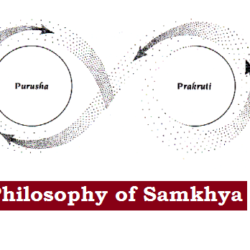
Jainism and Buddhism are two ancient Indian religions that developed in Magadha Kingdom and continue to thrive in the modern times. Mahavira and Gautama Buddha are generally accepted as contemporaries (5th century BCE). Jainism and Buddhism share many features, terminology and ethical principles, but emphasize them differently. Jainism and Buddhism emerged as the most potent religious reform movements.
Causes of Rise:
- Conflict arisen from Varna divided social order
- Kshatriyas against the ritualistic domination of Brahamanas
- Spread of a new agricultural economy in the NE India (Magadh Region):
- Killing of animals for food by Non-Aryans and sacrificing them by Aryans stood in the way of economic progress
- Increased importance of Vaishyas after the development of trade and commerce (starting of coins helped them to accumulate wealth)
Support for New Religions:
- Jainism and Budhhism did not give any importance to Varna system
- They preached non-violence, which means end to wars and promotion of trade
- Dharmasastras decried lending money on interest, Vaishyas were eager to improve
- They were against the material advancement and private property (reason for wars and conflicts)
Jainism
According to Jaina traditions, Jainism originated in 9th century BC and propagated by 24 Tirthankars, first being Rishabh Dev and last Vardhaman Mahaveer. Mahaveer was the real founder of Jainism. He was born in 540 BC (Vaishali) to royal family father Siddharth and mother Trishala (Lichhvi princess).
He attained Omniscience (Kaivalya) and became Mahavir or Jina (Conqueror) at the age of 42 and died in 468 BC (Pavapuri, Rajgir)
Philosophy of Jainism:
- It mainly aims at attainment of freedom from worldly bonds without any ritual but through ‘Triratna’ (Three Jewels): (KFA)
- Right knowledge
- Right Faith
- Right action
- Right action include five doctrines:
1. No violence 2. No lie 3. No stealing 4. No property 5. Brahmacharya
- Jainism attached the utmost importance to non-injury to living beings.
- They recognized the existence of Gods but placed them lower than Jina.
- They believed in soul and soul can achieve divine consciousness through its own efforts.
- It did not condemned the Varna system and held sins and virtues of previous birth responsible for birth in a particular Varna
- Everyone including lower caste can attain liberation
Spread:
- They used Prakrit language of common people for preaching
- Both men and women were admitted to the order
- Spread to south and west India where Brahmanical religion was weak
- Bhadrabahu led a mission to south and established a centre at Sravanbelgola (Karnataka)
- Chandragupta Maurya became Jaina and spent last years of his life in Karnataka as an ascetic
- Two factions developed- followers of Bhadrabahu were called Digambars and that of Shalbahu were called Shwetambars.
| Shwetambars Vs Digambars Shwetambars: 1. Shwetambar sect were liberal and they wore white clothes. 2. They believe in Sabastra Mukti, that women can attain salvation. 3. The Swetambar Jains holds that Mahavira Swami married and ruled and had a daughter. They are also of the view that the 19th Tirthankara was a lady Mallahkumari. Digambars: 1. The Digambar sect observed the tenets of religion strictly and the monks remained naked. 2. They believe that because of certain deformities peculiar to their sex, women cannot attain Mukti in the present life, but can do so in a future birth. However, they can, at the same time, observe the great vows and lead a true Jain life. 3. They hold that Mahavira Swami was a Bal Brahmachari and he had never married, nor did he have any raj. They do not believe that in the Kaivalya condition Mahavira Swami had any illness. |
Jaina Councils:
- First Council (3 century BC)- Patliputra under Sthalbahu
Jaina canons were compiled - Second Council (6 century AD): Valabhi under a Shwetambar
12 Angas (Jaina literature) and 12 Upangas (exposition to Angas) were compiled.
Contributions:
- First attempt to mitigate the evils and Varna and ritualistic domination
- Promoted the use of common language (Prakrit)
- Many regional language developed out of Prakrit languages, Marathi from Shauraseni
- They helped in literature, art, sculptures and architecture
Limitations:
- It did not clearly mark itself out from the Brahamanical religion
- Emphasis of extreme non-violence and even agriculture was prohibited
- Later rituals made their way into the religion and image worshiping started
Buddhism
Gautama Buddha was a contemporary of Mahavir, born in 563 BC in Lumbini to Shakya king and Koshalan princess. At the age of 29, he left home and at 35, he was enlightened, died in 483 BC (Kushinagar)
Philosophy of Buddhism:
- It mainly aims at attaining ‘Nirvana’ (free from cycle of birth and death) by conquering desires.
- He said world is full of misery on account of
desires and recommended an Eight Fold
Path (Ashtangika Marg) of meritorious life for the elimination:
- Right observation, determination, speech, action, livelihood, exercise, memory and meditation. (MALES MODM)
- There are three elements in Budhhism: Buddha, Sangha, and Dhamma.
- He doesn’t recognize the existence of God and soul. There is no transmigration of soul and it dies with person.
- He proved to be practical and did not involve in fruitless controversies regarding the soul and the Brahma, but addressed to worldly problems.
- He preached the ‘middle path’ avoiding excess of both luxury and austerity.
- He laid down a code of conduct: similar to 5 actions of Jainism
- No to property of others, corrupt practices
- No to violence, intoxicants, lie
Spread:
- It was practical and was free from fruitless controversies of soul and Brahma, it appealed to common people.
- It attacked the Varna system and won the support of people from lower orders. It also admitted women to Sangha.
- In comparison to Brahamanism, it was liberal and democratic.
- In the non- Vedic areas it made a special appeal, which was placed outside the holy Aryavarta by the Brahmanas.
- Use of Pali, the language of people contributed to the spread.
- The personality of Buddha and his methods of preaching and organizing Sangha (organised preaching) also helped in spread.
- Patronage of Ashoka, who embraced it 3 century BC, and helped Buddhism spread into Central Asia and South East Asia.
Buddhist Councils:
- First council: Rajgir, under Ajatsatru
- Buddhist discourse were collected and compiled in the form of ‘Tripitika’- Vinaya Pitaka (rules for monks), Sutta Pitaka (discourse of Buddha), Abhidhamma Pitaka (Philosophical exposition of Dhamma)
- Second Council: Vaishali,
- Lax practices in the monasteries attacked
- Third Council: Patna, under Ashoka
- To purify Buddhist movement
- Fourth Council: Kashmir, under Kanishka
- To systematize Abhhidhamma texts.
Sects of Buddhism:
There are many sects within Buddhism, but most can be classified into three major branches:
• Theravada (“Way of the Elders”)
• Mahayana (“Greater Vehicle”)
• Vajrayana (“Diamond Vehicle”)
| Theravada: Theravada, the most ancient form of Buddhism, is the dominant school in Southeast Asia (Thailand, Myanmar, Burma, Cambodia, and Laos). Its name translates to “Doctrine of the Elders,” and it centres around the Pali scriptures. By studying these ancient texts, meditating, and following the eight-fold path, Theravada Buddhists believe they will achieve Enlightenment. Strong emphasis is also placed on the monastic community and on heeding the advice of the wise. |
| Mahayana:Mahayana Buddhism developed out of the Theravada tradition around first century AD is dominant school in East Asia. Mahayana Buddhism focuses on the idea of compassion and touts Bodhisattvas, which are beings that work out of compassion to liberate other sentient beings from their suffering, as central devotional figures. A number of individual schools and traditions have formed under the Mahayana school, such as: Zen, Pure Land and Tantric Buddhism |
| Vajrayana: Vajrayana Buddhist tradition is an esoteric sect that is predominant in Tibet and Nepal. Vajrayana was last of the three ancient forms to develop, and provides a quicker path to Enlightenment than the other two. They believe that the physical has an effect on the spiritual and that the spiritual, in turn, affects the physical. Vajrayana Buddhists encourage rituals, chanting, and tantric techniques, along with a fundamental understanding of Theravada and Mahayana schools, as the way to attain Enlightenment. |
Contributions:
- It attacked the accumulation of wealth and recommend to remove poverty. The code of conduct prescribed for the monks represents a reaction against material conditions.
- It made an important impact on society by keeping its doors open for women and shudras.
- It preached non-violence and boosted the cattle wealth, and emphasized the sanctity of animal life.
- It preached a new awareness to take things by logic and arguing things on merit.
- It helped the development of Pali literature. Many Pali canons ‘Tripitaka’ were created for spreading Buddhism.
- It spread learning through monasteries like Nalanda, Vikramshila.
- It made a mark on art and architecture of ancient India. The first statues made in India were those of Buddha and his life events. Cave architecture was developed for the residence of Buddhist monks.
Limitations:
- It eventually succumbed to the rituals and ceremonies it originally denounced.
- There was division into Hinayana and Mahayana. Hinayana believed in letter of Buddha’s teachings and not the spirit and adopted Pali whereas Mahayana believed in deitification of Buddha and adopted Sanskrit for religious literature.
- Buddhist monks did not participate directly and lived on alms and gifts given by the society.
- The Buddhist centers became corrupt by the rich offerings and the royal grants with exploitation of women.
- It helped in consolidation of changes in the society, debtors and slaves were not permitted to the Sangha, which helped the richer section to exploit them.
- The path to Nirvana provided was confined to monks and there was no escape provided for lay followers.
- Finally, the large scale antipathy of Brahmana rulers against Buddhists caused the decline that prosecuted them, and destroyed the stupas and monasteries.
- Brahmana ruler Pashyamitra Shunga is said to have prosecuted them, also, the riches of monasteries became the target of Turkish invaders.

 Home
Home Syllabus
Syllabus Contact Us
Contact Us








